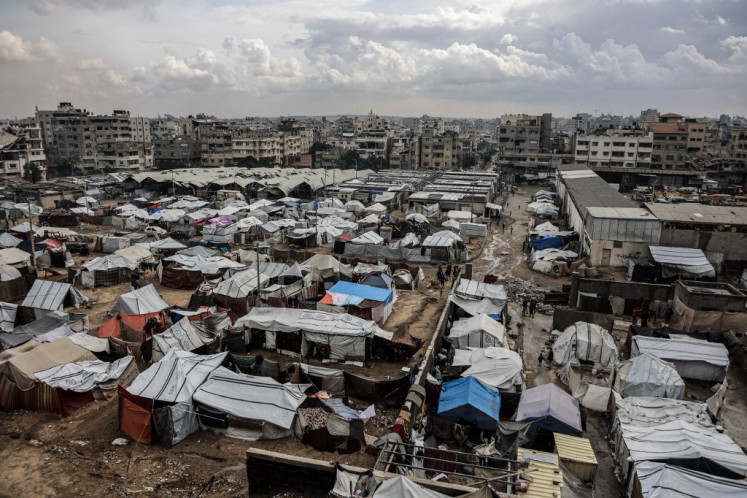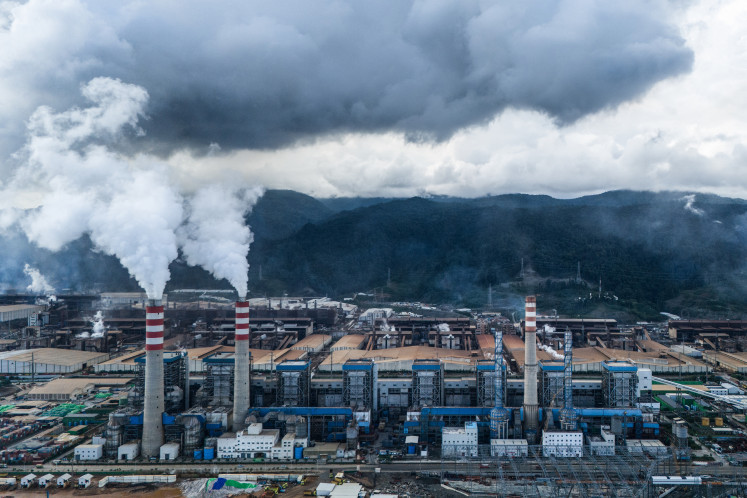Popular Reads
Top Results
Can't find what you're looking for?
View all search resultsPopular Reads
Top Results
Can't find what you're looking for?
View all search resultsStainless steel manufacturers face raw material scarcity in nickel-rich Indonesia
Despite becoming the world’s number one stainless steel products exporter, Indonesia is finding its local industry pinched, as producers are deprived of raw materials to keep manufacturing going, while having to deal with a barrage of imported finished products.
Change text size
Gift Premium Articles
to Anyone
D
espite becoming the world’s number one stainless steel exporter, Indonesia is finding its local industry pinched, as producers are deprived of raw materials to keep manufacturing going, while having to deal with a barrage of imported finished products.
Amid the challenges, industrialists are urging the government to amend its policy to save dying local stainless steel product manufacturers.
The Indonesian Stainless Steel Development Association (PPSSI) told The Jakarta Post that producers have been having difficulties in importing enough stainless steel raw materials to make finished products like kitchenware, cutlery, sinks and wash basins, among many other items.
Producers have to face a complicated, yet tiring, bureaucratic process to acquire a quota and those who make it to the end are only able to acquire between 10 and 15 percent of their actual required imports, the association said.
Many local producers have seen their production go into steep decline over the past years with several of them being forced to cease production due to an absence of stainless steel as a raw material. Among them are small and medium producers.
“I am afraid if the government continues to adopt the wrong policy on imports, this could lead to the demise of the local stainless steel industry,” PPSSI chairman Steven Ponny Sutiono told the Post on Dec. 5.
Read also: New commodity balance scheme may ward off Indonesia's steel import boom
Steven went on to say that the government had made the decision to restrict imports to protect the local stainless steel industry, but he said the policy may have missed its actual target, arguing that rather than protecting local producers, it is actually counterproductive to the development of the industry.
The PPSSI estimates Indonesia is capable of producing around 3.5 million tonnes of stainless steel annually, much larger than the local demand of between 400,000 and 500,000 tonnes annually.
With that capacity, Indonesia has emerged as the world’s number-one exporter, accounting for 67 percent of global supply in 2021.
However, producers said the one type of stainless steel that Indonesia has in abundance for export is that which contains between 8 and 12 percent of nickel, also known as the 300s series.
Meanwhile, local producers use the types containing between 0.3 and 1 percent of nickel or none at all, known as the 200s and 400s series, respectively, which have yet to be produced locally.
The higher the nickel content means the stainless steel product has greater corrosion resistance.
The International Stainless Steel Federation (ISSF) calculates that both the 200s and 400s series account for almost half the global stainless steel market, compared with the 300s.
Steven urged the government to rethink its import restrictions, arguing they should not be applied blindly to all types of stainless steel, including the types that the country cannot produce.
Furthermore, Steven questioned the government’s decision to allow large numbers of imports of finished stainless steel products, which continue to squeeze local producers, implying there may have been inconsistency in the restrictions.
Steven said local finished stainless steel products were of equally good quality to their imported counterparts and could take on the competition. Unfortunately, the lack of raw materials had led them to lose their competitive edge.
The average import value of stainless steel only grew by around 6 percent between 2017 and 2021 compared with the previous five years, while the average import value of finished goods made from stainless steel such as kitchenware, home appliances, sinks and wash basins grew at a faster rate at 48 percent for the same period, according to data collected from the United Nations Comtrade.
The Trade Ministry acknowledged that the government had imposed import restrictions on stainless steel to protect the local industry, but it declined to take responsibility for the difficulties caused by the stainless steel import policy.
The ministry argued it only carried out what was underlined by the Industry Ministry, which had the authority to issue import recommendations, referred to by the Trade Ministry as “technical considerations” for both stainless steel materials and finished products.
“We only determine the import quota based on ‘technical considerations’ made by the Industry Ministry,” Sihard Hadjopan Pohan, director of imports at the Trade Ministry told the Post on Dec. 15.
Industry Ministry spokesman Febri Hendri Antoni said on Dec. 15 that the ministry was preparing its response, but the promised answer had yet to be delivered by the time of publication.
Read also: Chinese state-controlled steel giant to take over nickel hub in Morowali: reports
Andry Satrio Nugroho, who heads the Center of Industry, Trade and Investment at the Institute for Development of Economics and Finance (Indef), said the prevailing import policy could render the local industry even less competitive and lead to more producers closing their business due to a lack of raw materials.
Andry said the government ought to help the local industry secure enough raw materials to support making finished products, arguing that the country had no homegrown intermediate manufacturing facility that was capable of producing the type of stainless steel required by local downstream producers.
“I understand the government wants badly to cut imports of stainless steel, but looking at the way the policy is devised, it will be only a panacea,” Andry said on Monday.
The PPSSI’s Steven said it was possible for Indonesia to have its own intermediate manufacturing facility to produce 200s and 400s stainless steel types, but it would require a large investment, which investors are not yet interested in due to the country’s small consumption of stainless steel-based products.
ISSF data show Indonesia’s stainless steel product consumption per capita ranked the lowest among 20 countries surveyed in 2021, at pretty much the same level as it was a decade previously.
Silmy Karim, chairman at the Indonesian Iron and Steel Industry Association, told the Post that an import restriction might be needed to protect newly established manufacturing facilities as part of the government’s assurance for investors that their investment would be worthwhile.










